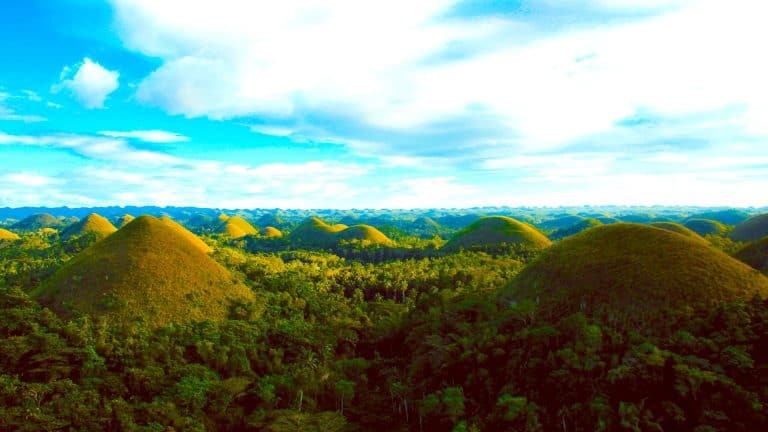The Carmen Bohol Chocolate Hills are a distinctive geological formation in the Philippines, consisting of over 1,200 symmetrical, grass-covered hills. Spanning more than 50 square kilometers in Bohol province, these cone-shaped mounds transform from green to brown in the dry season, resembling chocolate drops and drawing visitors worldwide for their unique beauty and intriguing folklore.
Table of Contents
Top 10 Questions and Answers about the Carmen Bohol Chocolate Hills:
What are the Carmen Bohol Chocolate Hills?
The Carmen Bohol Chocolate Hills are a unique geological formation in Bohol, Philippines. They are a cluster of more than 1,200 symmetrical, cone-shaped hills spread over an area of more than 50 square kilometers.
Why are they called Chocolate Hills?
They are named ‘Chocolate Hills’ because during the dry season, the green grass covering the hills turns brown, making them resemble giant chocolate mounds.
How were the Chocolate Hills formed?
The Chocolate Hills are thought to have been formed from limestone, shaped by erosion and surface uplift. The rainwater and carbon dioxide combined to erode the limestone over thousands of years, forming these unique shapes.
Can you climb the Chocolate Hills?
While you cannot climb every hill, there are designated viewing areas for tourists. The most popular one is the Chocolate Hills Complex in Carmen, which has an observation deck.
What is the best time to visit the Chocolate Hills?
The best time to visit is during the dry season, from late November to May. During this period, the hills are most likely to have their distinctive chocolate brown color.
Are the Chocolate Hills a UNESCO World Heritage Site?
As of now, the Chocolate Hills are not a UNESCO World Heritage Site, but they are a famous tourist destination and a renowned natural geological formation.
Is there any legend associated with the Chocolate Hills?
Yes, one popular legend is that the hills were formed by the tears of a heartbroken giant, while another tells of a battle between two giants who hurled rocks at each other, which then became the hills.
What wildlife can be seen around the Chocolate Hills?
The area around the Chocolate Hills is home to a variety of wildlife, including birds, insects, and small mammals. However, the hills themselves are mostly devoid of large wildlife due to their geological nature.
How do the local people perceive the Chocolate Hills?
The Chocolate Hills are a source of pride for the local people. They are not only a major tourist attraction but also an integral part of the local culture and folklore.
Are there any facilities for tourists at the Chocolate Hills?
Yes, there are facilities for tourists, including the Chocolate Hills Complex which has an observation deck, a restaurant, and souvenir shops. There are also other amenities in the towns nearby.
Guides and Tours:
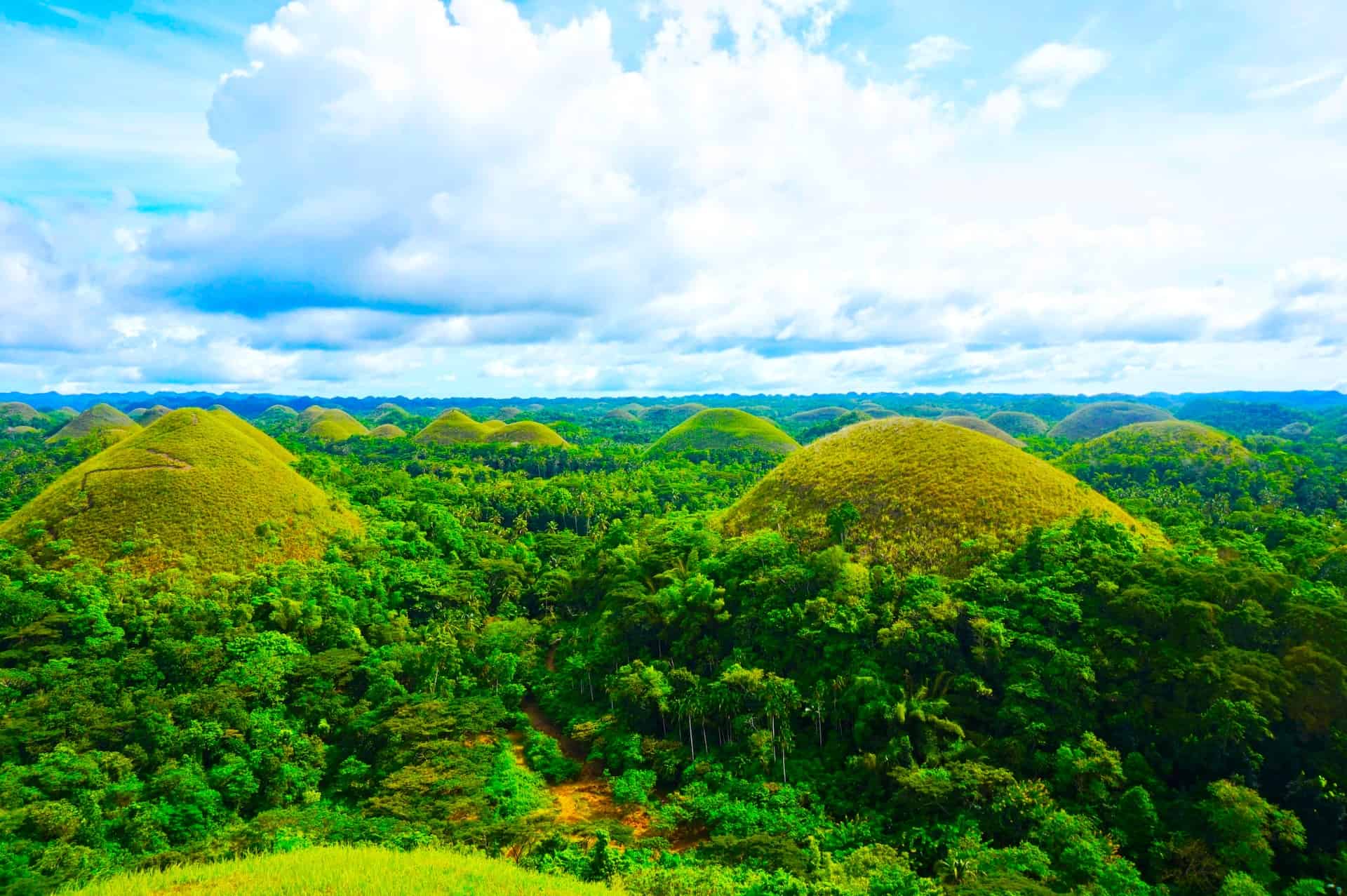
What are the Carmen Bohol Chocolate Hills and why you should go:
Visiting the Carmen Bohol Chocolate Hills is a journey into a world where nature’s artistry is displayed in its full glory. These geological wonders, nestled in the heart of Bohol, Philippines, offer a unique experience that combines natural beauty, cultural richness, and a sense of adventure.
The Awe-Inspiring Natural Beauty
The most striking allure of the Bohol Chocolate Hills is their surreal landscape. Over 1,200 symmetrical mounds spread across 50 square kilometers, like an endless sea of green that turns into a rich brown during the dry season. This natural phenomenon is not just visually stunning but also a marvel of geological evolution, making it a must-see for nature enthusiasts and geologists alike.
A Cultural Treasure Trove
The Carmen Bohol Chocolate Hills are deeply embedded in the local culture and folklore. The legends surrounding their creation, involving giants and mythical tales, add a layer of mystique to your visit. Exploring the hills provides a deeper insight into the rich cultural tapestry of Bohol, with each hill seemingly holding a story of its own.
An Adventure Seeker’s Paradise
For those who love outdoor adventures, the Bohol Chocolate Hills offer numerous opportunities. From hiking up to the observation decks for panoramic views to biking around the scenic trails, there’s no shortage of ways to immerse yourself in this extraordinary landscape. The hills challenge and reward adventurers with breathtaking vistas and a sense of achievement.
Photography and Memory Making
Photographers, both amateur and professional, will find the Bohol Chocolate Hills an endless source of inspiration. The changing colors of the hills, the play of light and shadow, and the overall grandeur of the landscape present perfect opportunities for capturing stunning images. Each photograph taken here tells a unique story, making it a cherished memory for years to come.
Eco-Tourism and Conservation Efforts
Visiting the Carmen Bohol Chocolate Hills is not just about enjoying their beauty; it’s also an opportunity to learn about and contribute to conservation efforts. The area is a model for eco-tourism, offering insights into how tourism can coexist with environmental preservation. Visitors can learn about the local flora and fauna, the ecological significance of the hills, and the efforts being made to protect this magnificent site.
Accessibility and Amenities
Accessibility is a key aspect of the Bohol Chocolate Hills’ appeal. The main viewing complex, located near Carmen, is easily reachable and well-equipped with amenities, ensuring a comfortable visit for tourists of all ages. The efforts to make this natural wonder accessible to everyone underscore the importance of inclusive tourism.
A Cultural Escape
A visit to the Bohol Chocolate Hills transcends a mere sightseeing trip. It’s an opportunity to escape into a world where nature and culture blend seamlessly. The hills, with their majestic presence, invite you to ponder, reflect, and appreciate the wonders of our planet.
Connecting with the Local Community
Engaging with the local community around the Chocolate Hills adds a rich layer to the travel experience. Visitors can enjoy local cuisine, interact with the friendly residents, and learn about the Boholanos’ way of life. This interaction not only enriches your travel experience but also supports local livelihoods.
An Ideal Destination for All
Whether you are a solo traveler seeking inspiration, a couple looking for a romantic getaway, or a family on an educational adventure, the Carmen Bohol Chocolate Hills cater to all. Their universal appeal lies in their ability to offer something special to every visitor.
Concluding Thoughts
The Carmen Bohol Chocolate Hills are a testament to the beauty and mystery of the natural world. They offer an experience that is both awe-inspiring and humbling, reminding us of the wonders that lie beyond our urban landscapes. A visit to these hills is more than just a trip; it’s a journey into the heart of nature’s artistry, a cultural exploration, and a contribution to the preservation of one of the world’s most extraordinary natural wonders.
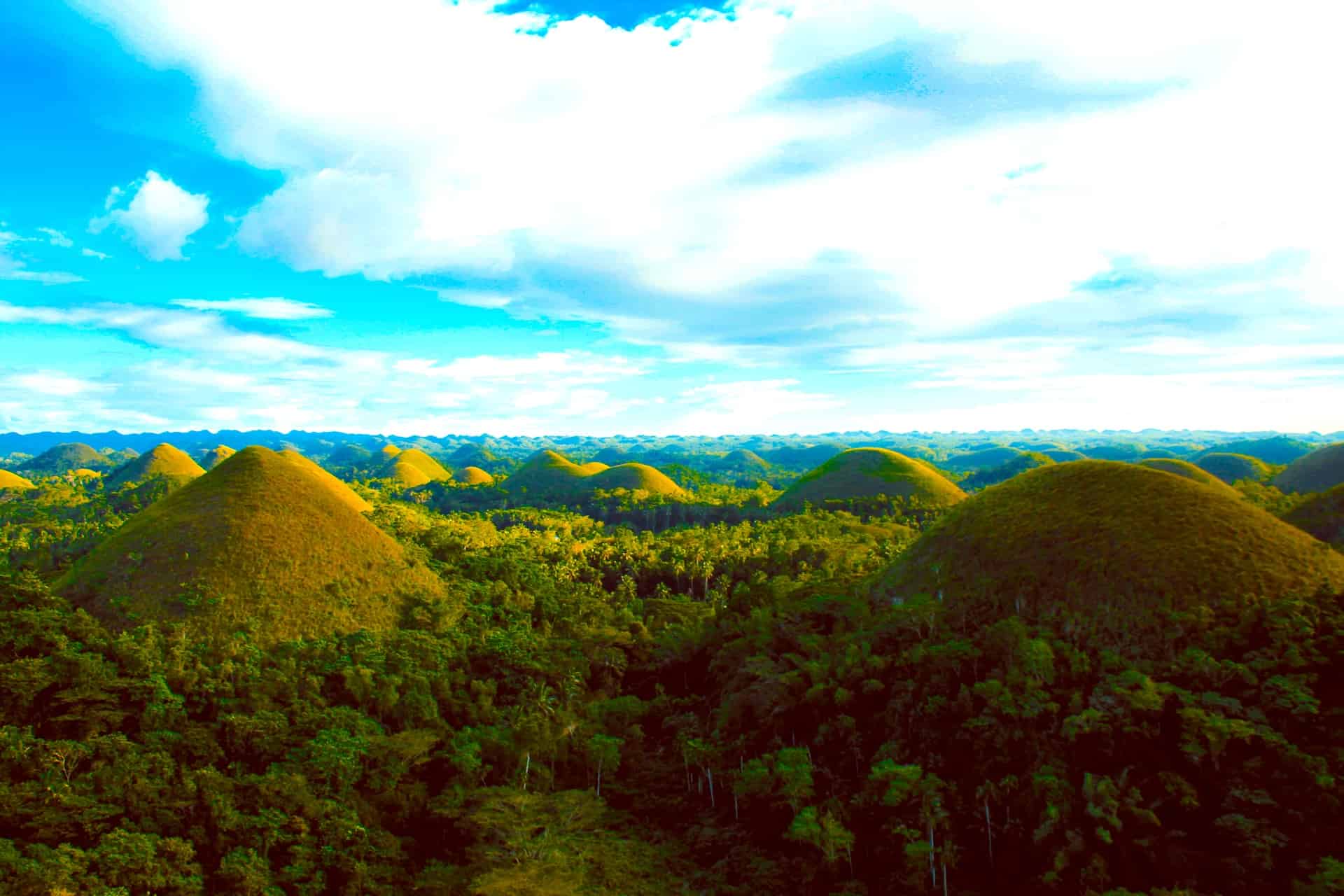
Carmen Bohol Chocolate Hills Facts:
1: Introduction to the Majestic Carmen Bohol Chocolate Hills
The Enigmatic Charm of the Bohol Chocolate Hills
Nestled in the heart of the Philippine archipelago is a geological marvel that captures the imagination of all who behold it – the Carmen Bohol Chocolate Hills. This extraordinary landscape in the Bohol province is not just a testament to the whims of nature but also a symbol of the Philippines’ rich natural heritage. As one of the most famous tourist attractions in the country, the Bohol Chocolate Hills evoke a sense of wonder and curiosity. Their unique and almost uniform cone-shaped mounds stretch over an area of more than 50 square kilometers, predominantly in the towns of Carmen, Batuan, and Sagbayan.
Geographical Location and Accessibility
The Bohol Chocolate Hills are centrally located on Bohol Island, easily accessible from the capital city of Tagbilaran. The journey to the hills themselves is an adventure, offering glimpses into the lush landscapes and vibrant culture of Bohol. As visitors approach the town of Carmen, the hills begin to dominate the horizon, their sheer number and size becoming increasingly apparent. The main viewing complex, located near Carmen, provides panoramic views of these hills, which number between 1,260 and 1,776 according to various estimates.
An Overview of Their Distinctive Features
The most striking feature of the Bohol Chocolate Hills is their uniformity in shape and size. Most of the hills are almost perfectly cone-shaped, although a few are more dome-shaped or half-buried. They vary in height but are generally between 30 to 50 meters tall, with the tallest hill rising to 120 meters. The grass-covered hills turn a distinct brown during the dry season, resembling endless rows of chocolate kisses, hence their name. This transformation adds a dynamic aspect to their appearance, making them a year-round attraction.
Cultural and Historical Context
The Carmen Bohol Chocolate Hills are not only a natural wonder but also a cultural icon. They are deeply ingrained in the local folklore and have been a part of the Boholano culture for generations. Legends abound about their formation, from giants hurling stones at each other to a heartbroken giant weeping over lost love. These stories, passed down through generations, add a mystical charm to the hills and deepen the connection between the local community and this natural wonder.
Scientific Curiosity and Studies
Scientists, however, offer a different explanation for the formation of the Bohol Chocolate Hills. While there is no consensus, the most widely accepted theory suggests that they are the result of the uplift of coral deposits and the action of rainwater and erosion. These theories continue to evolve with ongoing geological studies, adding to the hills’ intrigue. The scientific interest in the Bohol Chocolate Hills is not just limited to their formation but also extends to the rich biodiversity of the area, which includes several endemic species of flora and fauna.
The Bohol Chocolate Hills in Modern Times
Today, the Carmen Bohol Chocolate Hills are more than just a natural spectacle; they are a symbol of Bohol’s identity and a major driver of its tourism industry. The development of viewing complexes and the inclusion of the hills in various travel itineraries have made them accessible to a global audience. They are not only a source of pride for the local community but also a crucial contributor to the local economy. The hills have become a must-visit destination for nature lovers, adventure seekers, and those who appreciate the extraordinary creations of our planet.
In summary, the Carmen Bohol Chocolate Hills are a remarkable natural phenomenon that captivates the hearts and minds of all who visit. Their unique appearance, rich cultural significance, and scientific interest make them one of the Philippines’ most treasured natural landmarks. As we delve deeper into the other sections of this article, we will explore the intricate details of their geological formation, cultural importance, ecological aspects, and much more, painting a comprehensive picture of this extraordinary wonder.
2: Unveiling the Geological Mysteries of the Carmen Bohol Chocolate Hills
The Geological Formation of the Hills
The Carmen Bohol Chocolate Hills, an iconic landmark in the Philippine archipelago, are as intriguing in their formation as they are stunning in their appearance. Geologists and naturalists have long been fascinated by these peculiarly shaped hills, leading to numerous studies and theories about their origin. The most widely accepted theory suggests that these hills are the result of thousands of years of erosion of limestone, shaped by a combination of the dissolution of the limestone and subsequent uplift.
Limestone and Coral Deposits: The Building Blocks
The story of the Bohol Chocolate Hills begins underwater, millions of years ago. The hills are primarily composed of marine limestone, the remnants of coral reefs that thrived in a warm, shallow sea that once covered the area. Over time, these coral reefs were subjected to geological processes, including tectonic movements, that eventually raised them above sea level. The unique characteristics of limestone, a rock that is particularly susceptible to dissolution by water, played a crucial role in shaping the hills.
The Role of Water and Erosion
Water is the chief sculptor of the Bohol Chocolate Hills. Over millennia, rainwater, slightly acidic from absorbing carbon dioxide from the air and soil, percolated through the ground, slowly dissolving the limestone and carving out cavities and fissures. During the dry season, the erosion process is less active, allowing the hills to maintain their shape. This interplay between the wet and dry seasons has been pivotal in forming the nearly symmetrical cone-shaped hills that we see today.
A Closer Look at the Hill’s Composition
Delving deeper into the composition of the Bohol Chocolate Hills reveals a fascinating array of minerals and elements. The limestone that forms the bulk of the hills is rich in calcium carbonate, a compound that arises from the skeletal fragments of marine organisms like coral and mollusks. This composition not only explains the origin of the hills but also their vulnerability to the erosive power of water. Samples of soil and rock from the hills show a mix of other minerals as well, including small quantities of quartz, clay, and iron oxide, the latter contributing to the hills’ characteristic brown hue during the dry season.
Comparisons with Other Limestone Landscapes
The Carmen Bohol Chocolate Hills are not the only limestone landscapes in the world, but they are among the most unique. Comparisons can be drawn with other karst landscapes, such as the Guilin Hills in China and the Burren in Ireland. However, the almost uniform, conical shape of the Bohol Chocolate Hills sets them apart. These comparisons offer valuable insights into the different ways limestone can be shaped by environmental and geological factors, providing a broader context for understanding the formation of these hills.
The Impact of Climate on Hill Formation
The climate of Bohol has played a critical role in the formation of the Chocolate Hills. The region experiences a tropical climate, with a distinct wet and dry season. The heavy rainfall during the wet season accelerates the erosion process, while the drier conditions of the dry season allow for a period of stability and minimal erosion. This cyclical process has been crucial in sculpting the hills over thousands of years. Climate change and its potential impact on this delicate balance is a topic of concern among scientists, as changes in precipitation patterns could alter the rate of erosion and, consequently, the appearance of the hills.
Ongoing Geological Changes and Research
The Carmen Bohol Chocolate Hills are not static but are subject to ongoing geological changes. While these changes occur over extended periods and are not immediately visible, they are an important area of study. Ongoing research into the hills’ geology includes monitoring their stability, understanding the effects of seismic activity in the region, and studying the impact of human activities, such as tourism, on their integrity. This research is vital for the conservation of the hills and for ensuring that they continue to captivate visitors for generations to come.
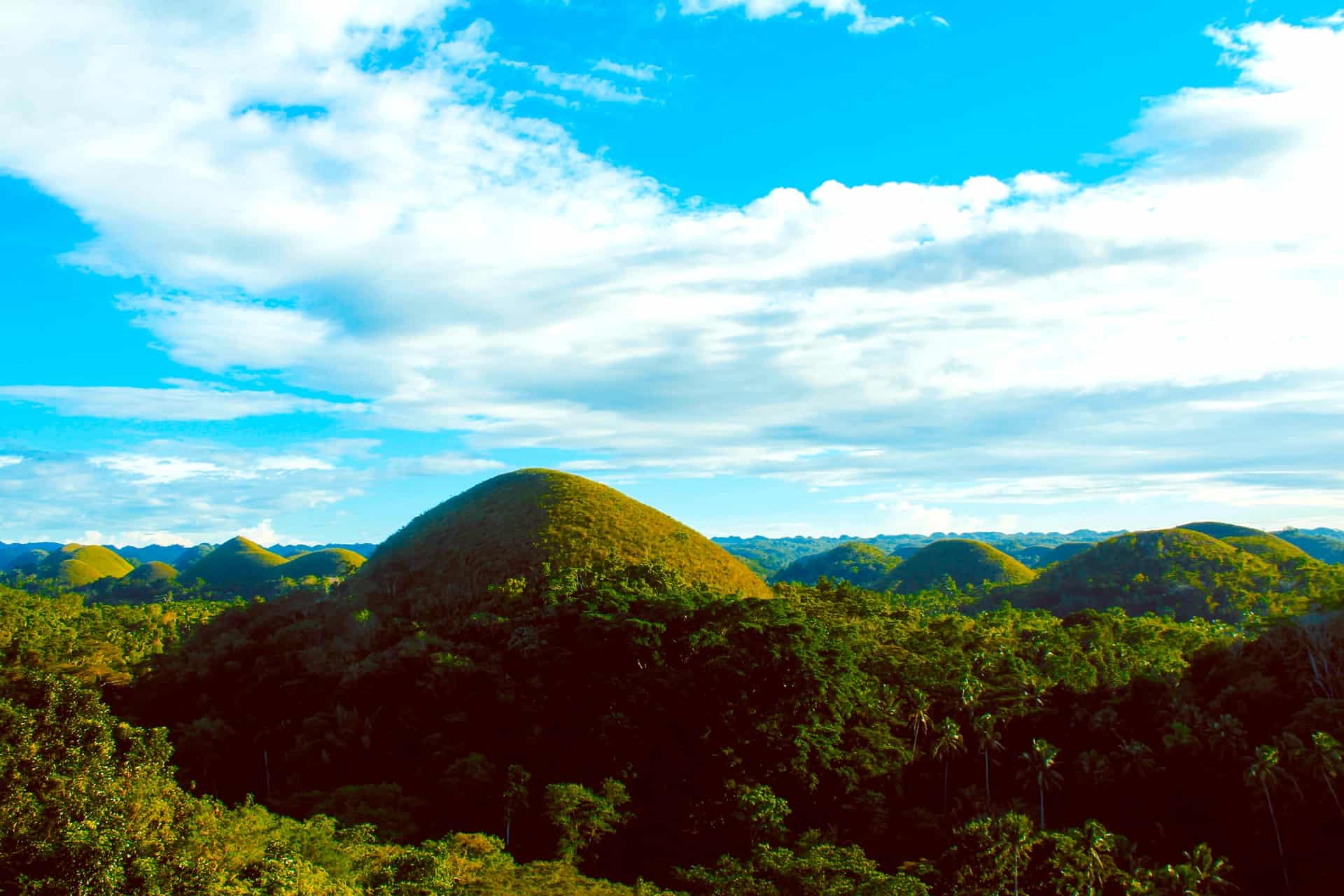
3: The Cultural and Historical Tapestry of the Carmen Bohol Chocolate Hills
Myths and Legends: The Folkloric Essence
The Carmen Bohol Chocolate Hills are steeped in local folklore, which adds a layer of mystique to their natural beauty. One popular legend tells of two feuding giants who hurled rocks and sand at each other, leaving behind the hills as remnants of their battle. Another tale speaks of a heartbroken giant, whose tears over lost love supposedly formed the hills. These stories, passed down through generations, reflect the hills’ deep-rooted significance in Boholano culture and their ability to inspire imagination and wonder.
Historical Significance and Local Traditions
Beyond myths, the Bohol Chocolate Hills hold a significant place in the historical and cultural landscape of Bohol. Their presence has been a constant backdrop to the evolving history of the island, from pre-colonial times to the present. Local traditions, celebrations, and arts often draw inspiration from the hills, showcasing their influence on the community’s identity. The Chocolate Hills are not just natural structures; they are symbols of the resilience and enduring spirit of the Boholanos.
Cultural Representations in Art and Media
The enchanting allure of the Carmen Bohol Chocolate Hills has been captured in various forms of art and media. From paintings and sculptures to music and literature, artists have found inspiration in their unique landscape. The hills have also graced the screen in films and documentaries, introducing their splendor to a global audience. These cultural representations play a crucial role in preserving and promoting the hills’ legacy, ensuring that their story continues to enchant future generations.
The Hills in Education and Research
Educational institutions in the Philippines and beyond have used the Bohol Chocolate Hills as a case study in various fields, including geology, environmental science, and cultural studies. The hills offer valuable insights into the complex interplay between nature and culture, serving as an outdoor classroom for students and researchers. Their unique formation also provides an excellent opportunity for geologists and naturalists to study karst landscapes and their ecosystems.
Festivals and Celebrations: Honoring the Hills
Festivals and celebrations in Bohol often pay homage to the Chocolate Hills. One notable example is the annual Chocolate Hills Festival, which celebrates the natural wonder and cultural heritage of the hills. This event features traditional music, dance, and other cultural performances, showcasing the vibrant community spirit and the pride of the Boholanos in their natural treasure.
The Hills in the Context of Philippine Heritage
The Carmen Bohol Chocolate Hills are an integral part of Philippine heritage. They stand as a symbol of the country’s rich and diverse natural landscapes, contributing to the national identity. Recognized as one of the Philippines’ most iconic natural wonders, the hills are a source of national pride and a testament to the country’s commitment to preserving its natural and cultural heritage.
4: The Ecological Wonderland of the Carmen Bohol Chocolate Hills
Diverse Flora: A Green Canopy
The Carmen Bohol Chocolate Hills are not just a geological wonder but also a hotspot of ecological diversity. The hills and their surrounding areas are home to a rich variety of plant species. These range from grasses that cover the hills, turning brown in the dry season and giving the hills their chocolatey appearance, to rare and endemic species found in the forests at the base of the hills. The flora plays a crucial role in maintaining the local ecosystem, providing habitat and food for various wildlife species.
Fauna: The Wildlife Inhabitants
The animal life around the Bohol Chocolate Hills is as varied as the plant life. This region supports a range of fauna, from common species to rare and endangered ones. Birds, insects, and small mammals are particularly abundant, with some species being unique to the region. The hills serve as a crucial refuge for these species, offering a haven away from the growing human settlements.
Endemic Species: Bohol’s Unique Inhabitants
Among the most notable aspects of the Chocolate Hills’ ecology are the endemic species that call this area home. These species, which are not found anywhere else in the world, include certain types of birds, insects, and plants. Their survival is closely tied to the health and preservation of the hills’ ecosystem. The study of these species provides valuable insights into biodiversity and the importance of conservation efforts.
Ecosystem Services: Beyond Aesthetic Value
The ecological significance of the Carmen Bohol Chocolate Hills extends beyond their aesthetic appeal. These hills and their surrounding environments provide essential ecosystem services. These include water filtration, carbon sequestration, and soil erosion control. By maintaining the health of these ecosystems, the hills contribute to the overall well-being of the region, supporting agriculture and aiding in climate regulation.
Conservation Efforts: Protecting the Hills’ Ecology
Recognizing the ecological importance of the Bohol Chocolate Hills, various conservation efforts have been implemented. These include protecting the area from excessive tourism, combating deforestation, and preserving the habitats of the endemic and endangered species. Local and national authorities, along with environmental organizations, are actively involved in these conservation efforts, aiming to maintain the delicate balance of this unique ecosystem.
Environmental Challenges and Future Prospects
Despite ongoing conservation efforts, the Bohol Chocolate Hills face several environmental challenges. These include the threats posed by climate change, habitat destruction, and the potential impact of invasive species. Addressing these challenges requires a multifaceted approach that includes scientific research, community engagement, and sustainable tourism practices. The future of the Chocolate Hills’ ecosystem depends on the effectiveness of these strategies and the continued commitment to preserving this natural treasure.
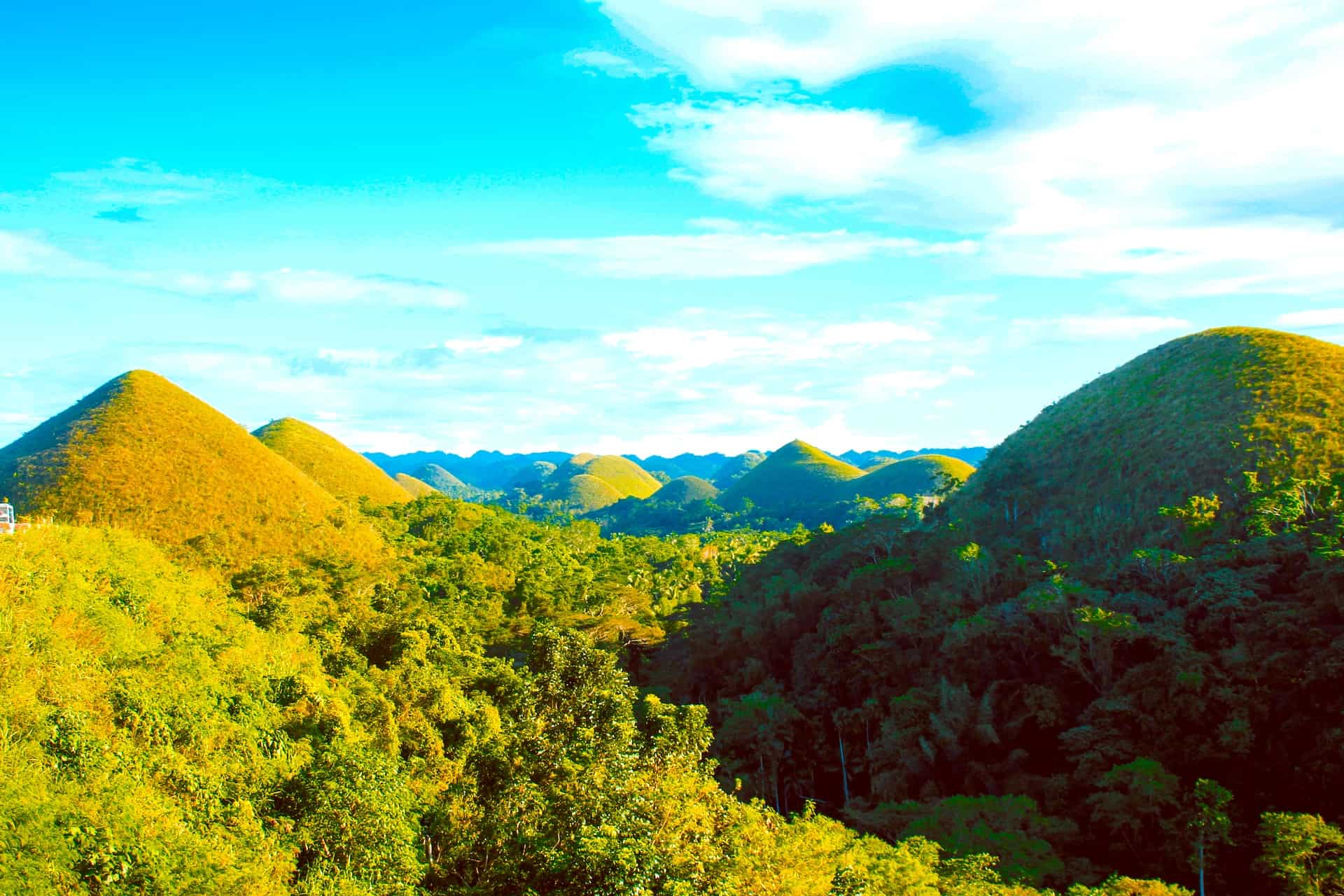
5: Tourism and Economic Impact of the Carmen Bohol Chocolate Hills
The Magnetism of the Hills: Attracting Global Visitors
The Carmen Bohol Chocolate Hills are not just a natural wonder but also a powerful magnet for tourism. Annually, thousands of visitors from around the globe flock to witness the unique beauty of these geological formations. The hills have become synonymous with Bohol’s identity, often featured in travel brochures and documentaries showcasing the Philippines’ natural attractions. The allure of the Chocolate Hills lies in their unique shape and the mystical stories surrounding their formation, captivating the imagination of travelers from all walks of life.
Economic Contributions: Boosting Local Livelihoods
The influx of tourists to the Bohol Chocolate Hills has significant economic implications for the local community. The tourism industry surrounding the hills has created numerous employment opportunities, from tour guiding and hospitality to local crafts and food services. This economic boost is vital for many residents in Carmen and neighboring towns, offering a sustainable source of income and contributing to the overall economic development of the region.
Infrastructure Development and Tourism Facilities
To accommodate the growing number of visitors, substantial investments have been made in developing infrastructure and facilities around the Bohol Chocolate Hills. This includes the construction of viewing decks, visitor centers, and improved road networks. While these developments have made the hills more accessible to tourists, they also raise questions about sustainability and environmental impact, necessitating careful planning and management.
Promoting Sustainable Tourism Practices
With the increasing popularity of the Carmen Bohol Chocolate Hills, the importance of sustainable tourism practices has come to the forefront. Efforts are being made to balance the economic benefits of tourism with the need to preserve the hills’ natural beauty and ecological integrity. Initiatives include regulating the number of visitors, promoting eco-friendly activities, and educating tourists about the importance of conservation.
Cultural Tourism: Celebrating Local Heritage
Tourism in the area is not limited to the natural appeal of the hills but also encompasses the rich cultural heritage of Bohol. Cultural tourism initiatives highlight local traditions, crafts, and history, providing a more holistic experience for visitors. These initiatives not only add depth to the tourist experience but also help in preserving and promoting Bohol’s cultural identity.
Future Prospects: Challenges and Opportunities
Looking ahead, the Bohol Chocolate Hills face both challenges and opportunities in the realm of tourism. The challenge lies in managing the environmental impact of increased visitor numbers and ensuring that tourism development is sustainable and benefits the local community. On the other hand, there are opportunities to innovate and expand the tourism experience, potentially including virtual reality tours, educational programs, and community-based tourism initiatives.
6: Challenges and Conservation Efforts at the Carmen Bohol Chocolate Hills
Understanding the Environmental Challenges
The Carmen Bohol Chocolate Hills, while majestic, face a series of environmental challenges that threaten their existence and the surrounding ecosystem. These challenges include soil erosion, the impact of climate change, and the pressure from increased tourism. Understanding these challenges is the first step towards implementing effective conservation strategies. Soil erosion, for instance, can be exacerbated by both natural processes and human activities, leading to a loss of biodiversity and degradation of the hills’ unique geological features.
Impact of Climate Change on the Hills
Climate change poses a significant threat to the Bohol Chocolate Hills. Changes in temperature and precipitation patterns can alter the natural processes that maintain the hills’ shape and vegetation. Increased frequency of extreme weather events, such as typhoons and droughts, can accelerate erosion and damage the fragile ecosystem. Understanding and mitigating the effects of climate change is crucial for the preservation of the hills.
Tourism: Balancing Economic Benefits and Environmental Impact
Tourism, while a vital source of income for the local community, brings its own set of challenges to the conservation of the Bohol Chocolate Hills. The influx of visitors can lead to environmental degradation if not managed properly. This includes littering, trampling of vegetation, and potential pollution. Balancing the economic benefits of tourism with the need to preserve the hills’ natural beauty is a complex but essential task.
Conservation Initiatives: Local and National Efforts
Several conservation initiatives have been put in place to protect the Bohol Chocolate Hills. These efforts range from local community projects to national government programs. Key initiatives include habitat restoration, reforestation, and the implementation of sustainable tourism practices. Community involvement is critical in these conservation efforts, as it ensures that the measures are culturally appropriate and supported by those who are most affected.
Role of Science and Research in Conservation
Scientific research plays a pivotal role in the conservation of the Carmen Bohol Chocolate Hills. Ongoing studies help in understanding the hills’ geology, ecology, and the impact of human activities. This research informs conservation strategies, ensuring they are based on solid scientific evidence. Collaboration between scientists, conservationists, and the local community is key to the success of these efforts.
Future Directions: Sustainable Management and Education
Looking to the future, sustainable management and education are vital for the continued conservation of the Bohol Chocolate Hills. Educating both locals and tourists about the importance of conservation can lead to more responsible behavior and support for conservation initiatives. Sustainable management involves not only protecting the hills but also ensuring that the economic benefits of tourism are distributed fairly and contribute to the well-being of the local community.
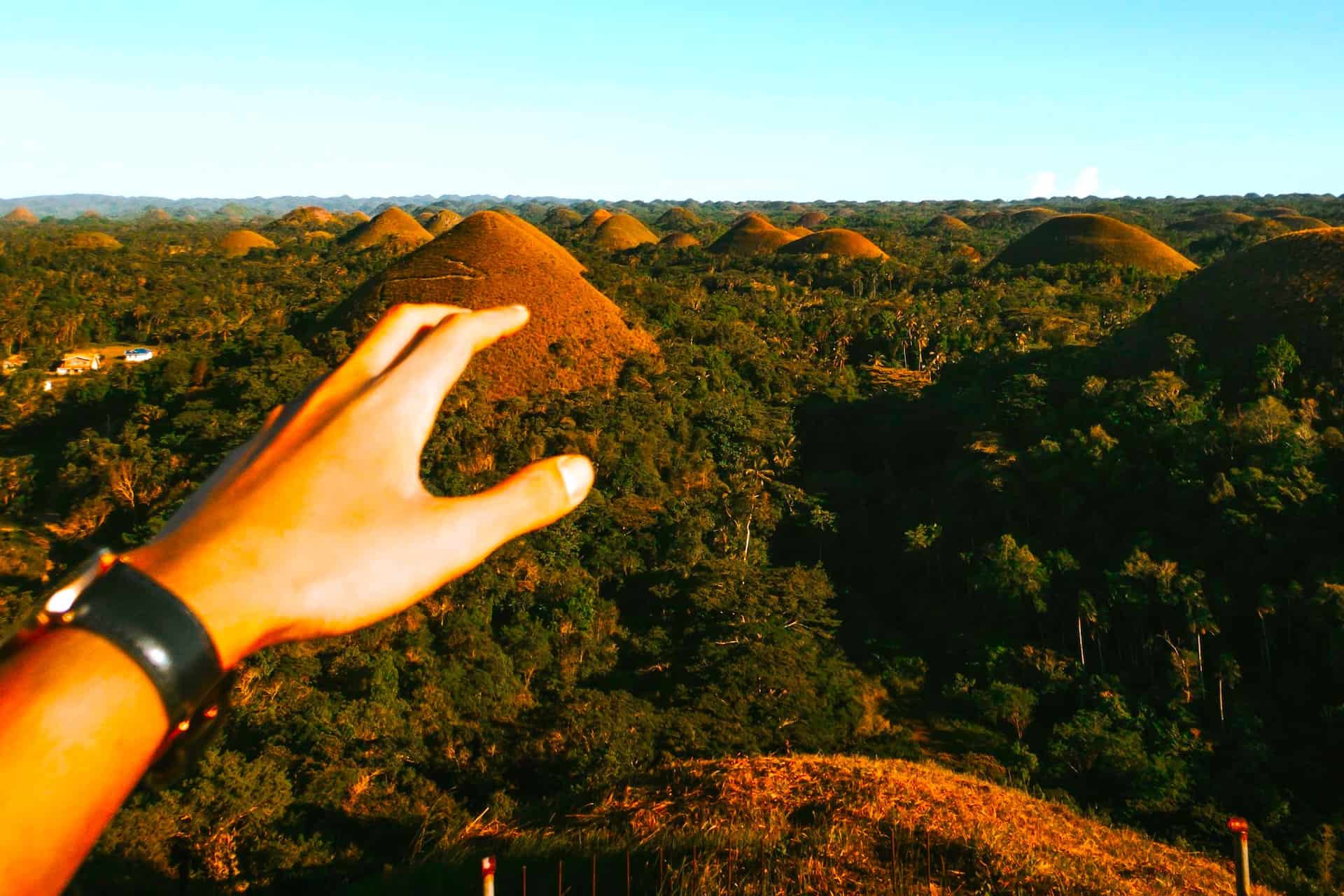
7: Personal Experiences and Travelogues at the Carmen Bohol Chocolate Hills
Journeys to the Hills: Traveler Tales
The Carmen Bohol Chocolate Hills have been the backdrop to countless journeys, each leaving visitors with unique memories and stories. Travelers from around the world share their experiences of awe and wonder when they first lay eyes on the extraordinary landscape. These personal accounts often include the journey to the hills, the first moment of seeing the vast expanse of conical mounds, and the emotional impact of being in such a unique natural setting.
Photographic Journeys: Capturing the Hills’ Essence
Photography enthusiasts find a particular allure in the Bohol Chocolate Hills, capturing their changing faces from the verdant green of the wet season to the chocolatey brown of the dry season. These photographs not only serve as personal mementos but also inspire others to visit and experience the hills for themselves. The play of light and shadow, the vastness of the landscape, and the unique shape of the hills provide endless opportunities for stunning photography.
Hiking and Exploration: Active Encounters
For the more adventurous, hiking and exploring the Carmen Bohol Chocolate Hills offers a more intimate experience with the landscape. These tales often involve treks up the hills, insights into the local flora and fauna, and encounters with the local community. Hikers share stories of the physical challenge of the climb, the panoramic views from the top, and the sense of accomplishment upon reaching the summits.
Cultural Connections: Insights into Local Life
Visitors to the Bohol Chocolate Hills often explore the surrounding communities, gaining insights into the local way of life. These experiences include interactions with local residents, participation in cultural events, and sampling traditional Boholano cuisine. Travelogues that delve into these cultural experiences provide a deeper understanding of the significance of the hills to the local community and the ways in which they shape local identity.
Reflections and Recommendations: From Travelers to Future Visitors
Many visitors to the Bohol Chocolate Hills leave with reflections and recommendations for future travelers. These can range from the best times of year to visit, tips for capturing the perfect photograph, to advice on respecting the natural environment and local customs. These personal insights are invaluable for those planning their journey to the hills, offering practical advice and enhancing the overall experience.
The Hills Through Different Eyes: Diverse Perspectives
The Bohol Chocolate Hills are experienced differently by each visitor, with perspectives influenced by one’s background, interests, and expectations. Some see them as a geological wonder, others as a cultural symbol, and still others as a source of inspiration or adventure. These diverse viewpoints enrich the narrative of the hills, showcasing their multifaceted appeal and the myriad ways in which they can be appreciated.
8: Future Prospects and Developments at the Carmen Bohol Chocolate Hills
Anticipating Changes: Environmental and Touristic Forecasts
The future of the Carmen Bohol Chocolate Hills is an intersection of environmental sustainability and touristic development. Anticipating how climate change might impact the hills is crucial for their preservation. Predictions suggest alterations in local weather patterns could affect the hills’ iconic appearance and the biodiversity they support. Simultaneously, the burgeoning tourism industry faces the challenge of evolving in a way that respects the delicate balance of this natural wonder.
Innovations in Tourism: Enhancing Visitor Experience
The Bohol Chocolate Hills are poised for innovative developments in tourism. Future plans could include augmented reality experiences that allow visitors to witness the hills’ formation over millennia or virtual tours for those unable to visit in person. These technological advancements could enhance visitor engagement while mitigating the impact of physical tourism on the environment.
Community Involvement: Shaping the Future
The role of local communities in shaping the future of the Bohol Chocolate Hills is invaluable. Community-led initiatives in sustainable tourism, conservation efforts, and cultural preservation are crucial. Future strategies might involve more community-based tourism models, where locals are not just beneficiaries but active participants in tourism development and environmental stewardship.
Conservation Efforts: Adapting to New Challenges
As environmental pressures mount, conservation efforts for the Carmen Bohol Chocolate Hills need to adapt and evolve. This could involve more sophisticated monitoring systems for tracking environmental changes, habitat restoration projects, and stronger regulations to protect the hills from overdevelopment and exploitation.
Education and Awareness: Building a Sustainable Future
Education and awareness campaigns are essential for the long-term preservation of the Bohol Chocolate Hills. Future initiatives might focus on educating visitors and locals about the ecological and geological importance of the hills, promoting responsible tourism practices, and highlighting the hills’ role in the global context of natural wonders.
A Global Icon: The Hills on the World Stage
The Carmen Bohol Chocolate Hills have the potential to become an even more prominent icon on the world stage. Efforts to gain more recognition, such as through UNESCO World Heritage status, could bring greater awareness and support for their preservation. Such recognition would not only celebrate the hills’ unique beauty but also emphasize their importance as a part of our global natural heritage.
9: Conclusion – Reflecting on the Splendor and Significance of the Carmen Bohol Chocolate Hills
A Natural Wonder Beyond Comparison
The journey through the Carmen Bohol Chocolate Hills is a journey through a landscape that defies ordinary descriptions. These natural marvels, with their conical shapes and ever-changing colors, stand as a testament to the wonders of the natural world. Beyond their geological uniqueness, the hills embody a blend of natural beauty, scientific intrigue, and cultural significance that is rare and captivating.
The Cultural Heartbeat of Bohol
Throughout this exploration, it’s become evident that the Bohol Chocolate Hills are more than just a tourist destination. They are deeply woven into the cultural fabric of the Bohol province. The legends, stories, and traditions that surround these hills resonate with the spirit of the Boholano people, offering a glimpse into the rich tapestry of Philippine folklore and heritage.
An Ecological Beacon of Biodiversity
The ecological aspects of the Carmen Bohol Chocolate Hills remind us of the fragile interdependence between humans and nature. The hills and their surrounding ecosystems harbor a variety of flora and fauna, some of which are unique to this region. The responsibility to protect and preserve these ecological treasures cannot be overstated, as they represent a vital part of the planet’s biodiversity.
Balancing Tourism and Sustainability
The economic impact of tourism centered around the Bohol Chocolate Hills has been significant. While it brings prosperity and development, it also brings challenges that require careful management and sustainable practices. The future of these hills depends on finding a balance that allows people to experience their majesty without compromising their integrity and longevity.
Conservation: A Shared Responsibility
The challenges facing the Carmen Bohol Chocolate Hills, particularly in the context of environmental conservation and climate change, highlight the need for collective action. It is a shared responsibility that involves local communities, government agencies, and global environmental groups. Protecting this natural wonder demands ongoing commitment, innovative conservation strategies, and public awareness.
Looking Forward: The Hills in Tomorrow’s World
As we look to the future, the Bohol Chocolate Hills stand as a beacon of natural beauty, cultural richness, and ecological significance. Their continued preservation and the sustainable development of the surrounding areas will require concerted efforts and forward-thinking policies. The hills, in all their majesty, are not just a relic of the past but a living part of our world, deserving of our utmost respect and care.
Bohol Chocolate Hills T-shirts
